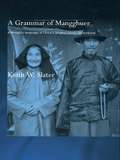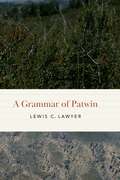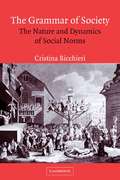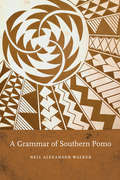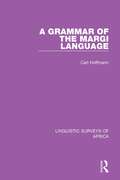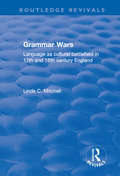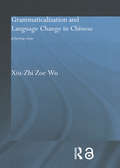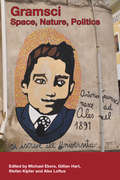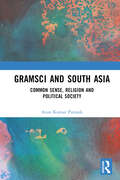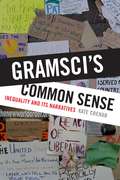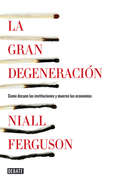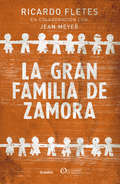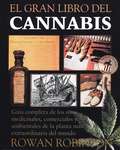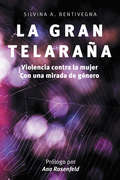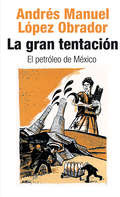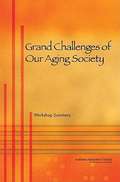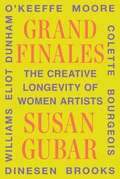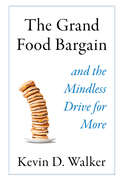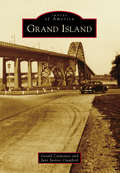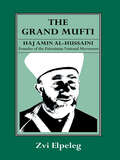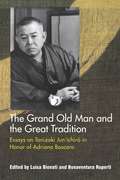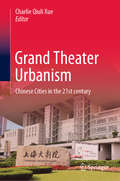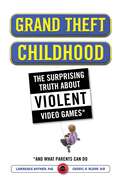- Table View
- List View
A Grammar of Mangghuer: A Mongolic Language of China's Qinghai-Gansu Sprachbund (Routledge Studies in Asian Linguistics)
by Keith W. SlaterThis book is a grammar of Mangghuer, a Mongolic language spoken by approximately 25,000 people in China's northwestern Qinghai Province. Mangghuer is virtually unknown outside China, and no grammar of Mangghuer has ever been published in any language. The book's primary importance is thus as a systematic grammatical description of a little-known language. The book also makes a significant contribution to comparative Mongolic studies. In addition to the synchronic description of Mangghuer, extensive comparison with other Mongolic languages is included, demonstrating the genetic relationship of Mangghuer within that family. In the course of describing Mangghuer linguistic structures, the book also examines issues of interest to linguistic typologists.
A Grammar of Patwin (Studies in the Native Languages of the Americas)
by Lewis C. LawyerPublished through the Recovering Languages and Literacies of the Americas initiative, supported by the Andrew W. Mellon Foundation. A Native American language formerly spoken in hundreds of communities in the interior of California, Patwin (also known as Wintun Tʼewe) is now spoken by a small but growing number of language revitalizationists and their students. A Grammar of Patwin brings together two hundred years of word lists, notebooks, audio recordings, and manuscripts from archives across the United States and synthesizes this scattered collection into the first published description of the Patwin language. This book shines a light on the knowledge of past speakers and researchers with a clear and well-organized description supported by ample archival evidence. Lewis C. Lawyer addresses the full range of grammatical structure with chapters on phonetics, phonology, nominals, nominal modifiers, spatial terms, verbs, and clauses. At every level of grammatical structure there is notable variation between dialects, and this variation is painstakingly described. An introductory chapter situates the language geographically and historically and also gives a detailed account of previous work on the language and of the archival materials on which the study is based. Throughout the process of writing this book, Lawyer remained in contact with Patwin communities and individuals, who helped to ensure that the content is appropriate from a cultural perspective.
The Grammar of Society: The Nature and Dynamics of Social Norms
by Cristina BicchieriIn The Grammar of Society, first published in 2006, Cristina Bicchieri examines social norms, such as fairness, cooperation, and reciprocity, in an effort to understand their nature and dynamics, the expectations that they generate, and how they evolve and change. Drawing on several intellectual traditions and methods, including those of social psychology, experimental economics and evolutionary game theory, Bicchieri provides an integrated account of how social norms emerge, why and when we follow them, and the situations where we are most likely to focus on relevant norms. Examining the existence and survival of inefficient norms, she demonstrates how norms evolve in ways that depend upon the psychological dispositions of the individual and how such dispositions may impair social efficiency. By contrast, she also shows how certain psychological propensities may naturally lead individuals to evolve fairness norms that closely resemble those we follow in most modern societies.
A Grammar of Southern Pomo
by Neil Alexander WalkerA title in the Recovering Languages and Literacies of the Americas initiative, supported by the Andrew W. Mellon Foundation.A Grammar of Southern Pomo is the first comprehensive description of the Southern Pomo language, which lost its last fluent speaker in 2014. Southern Pomo is one of seven Pomoan languages once spoken in the vicinity of Clear Lake and the Russian River drainage of California. Prior to European contact, a third of all Pomoan peoples spoke Southern Pomo, and descendants of these speakers are scattered across several present-day reservations. These descendants have recently initiated efforts to revitalize the language. The unique culture of Southern Pomo speakers is embedded in the language in several ways. There are separate words for the many different species of oak trees and their different acorns, which were the people&’s staple cuisine. The kinship system is unusually rich both semantically and morphologically, with terms marked for possession, generation, number, and case. Verbs similarly encode the ancient interactions of speakers with their land in more than a dozen directional suffixes indicating specific paths of movement.A Grammar of Southern Pomo sheds new light on a relatively unknown Indigenous California speech community. In many instances Neil Alexander Walker discusses phenomena that are rare or entirely unattested outside the language and challenges long-standing ideas about what human speech communities can create and pass on to children as well as the degree to which culture and place are inextricably woven into language.
A Grammar of the Margi Language (Linguistic Surveys of Africa #2)
by Carl HoffmannOriginally published in 1963, this was, and still is, the only Grammar to be published of the Margi language which is spoken by the people of the Adamawa and Bornu areas of Nigeria. Definitions and explanations ahve been given in as explicitya form as possible, especially where the average student could not be expected to be familiar with the terminology. Numerous examples have been added to illustrate the theoretical explanations.
Grammar Wars: Language as Cultural Battlefield in 17th and 18th Century England (Routledge Revivals)
by Linda C MitchellThis title was first published in 2001: Although 17th- and 18th-century English language theorists claimed to be correcting errors in grammar and preserving the language from corruption, this new study demonstrates how grammar served as an important cultural battlefield where social issues were contested. Author Linda C. Mitchell situates early modern linguistic discussions, long thought to be of little interest, in their larger cultural and social setting to show the startling degree to which grammar affected, and was affected by, such factors as class and gender. In her examination of the controversies that surrounded the teaching and study of grammar in this period, Mitchell looks especially at changing definitions and standardization of "grammar", how and to whom it was taught, and how grammar marked the social position of marginal groups. Her comprehensive study of the contexts in which grammar was intended or thought to function is based on her analysis of the ancillary materials - prefaces, introductions, forewords, statements of intent, organization of materials, surrounding materials, and manifestos of pedagogy, philosophy, and social or political goals - of more than 300 grammar texts of the time. The book is intended as a landmark study of an important movement in the foundation of the modern world.
Grammaticalization and Language Change in Chinese: A formal view (Routledge Studies in Asian Linguistics)
by Xiu-Zhi Zoe WuThis innovative study on the phenomenon of 'grammaticalization' and its manifestation in Chinese provides new insights into language change in Chinese and a large number of grammatical topics. Grammaticalization occurs in all of the world's languages. Xiu-Zhi Zoe Wu demonstrates general linguistic principles present and active in the phenomenon of grammaticalization whilst also describing the modelling of language in formal theoretical approaches to syntax; so this book fills two major gaps in the current study of linguistics. Grammaticalization and Language Change in Chinese illuminates how studies of language development and change provide special insights into the understanding of current, synchronic systems of language. Using patters from Chinese, the author establishes cross-linguistic generalizations about language change and grammaticalization. This book should be of great interest to Chinese linguists and readers interested in language change in different languages.
Gramsci: Space, Nature, Politics (Antipode Book Series #55)
by Michael EkersThis unique collection is the first to bring attention to Antonio Gramsci’s work within geographical debates. Presenting a substantially different reading to Gramsci scholarship, the collection forges a new approach within human geography, environmental studies and development theory. Offers the first sustained attempt to foreground Antonio Gramsci’s work within geographical debates Demonstrates how Gramsci articulates a rich spatial sensibility whilst developing a distinctive approach to geographical questions Presents a substantially different reading of Gramsci from dominant post-Marxist perspectives, as well as more recent anarchist and post-anarchist critiques Builds on the emergence of Gramsci scholarship in recent years, taking this forward through studies across multiple continents, and asking how his writings might engage with and animate political movements today Forges a new approach within human geography, environmental studies and development theory, building on Gramsci’s innovative philosophy of praxis
Gramsci and South Asia: Common Sense, Religion and Political Society
by Arun Kumar PatnaikGramsci’s theory of common sense is a metanarrative that can be used to explain both religion and political formations. This book examines Gramsci’s perspective and how his theories translate into South Asian society. It explores Gramsci’s historicism, which is sensitive to historical, regional and national differences, and its relevance in post-colonial societies.The volume discusses themes like common sense, religious common sense, folk religion, dialogue and common sense concerning civil/political society through the lens of Gramsci’s historical perspectives. It also looks at Gramscian critique of political secularism, the ideology and politics of Hindutva, civil society in a non-Western context and modes of political society in India.Lucid and topical, this book is a must-read for scholars and researchers of political studies, political philosophy, post-colonial studies, South Asian politics, cultural studies and political sociology.
Gramsci's Common Sense: Inequality and Its Narratives
by Kate CrehanAcknowledged as one of the classics of twentieth-century Marxism, Antonio Gramsci's Prison Notebooks contains a rich and nuanced theorization of class that provides insights that extend far beyond economic inequality. In Gramsci's Common Sense Kate Crehan offers new ways to understand the many forms that structural inequality can take, including in regards to race, gender, sexual orientation, and religion. Presupposing no previous knowledge of Gramsci on the part of the reader, she introduces the Prison Notebooks and provides an overview of Gramsci's notions of subalternity, intellectuals, and common sense, putting them in relation to the work of thinkers such as Bourdieu, Arendt, Spivak, and Said. In the case studies of the Tea Party and Occupy Wall Street movements Crehan theorizes the complex relationships between the experience of inequality, exploitation, and oppression as well as the construction of political narratives. Gramsci's Common Sense is an accessible and concise introduction to a key Marxist thinker whose works illuminate the increasing inequality in the twenty-first century.
La gran degeneración: Cómo decaen las instituciones y mueren las economías
by Niall FergusonUn análisis de las causas del declive actual de occidente. Hace tiempo que se anuncia el declive de Occidente, pero ahora los síntomas de esa decadencia nos acosan: un crecimiento mínimo, una deuda asfixiante, una población envejecida, conductas antisociales. ¿Qué le pasa a la civilización occidental? La respuesta que ofrece Niall Ferguson es que nuestras instituciones, los complejos marcos dentro de los que una sociedad puede florecer o fracasar, están degenerando. El gobierno representativo, el libre mercado, el imperio de la ley y la sociedad civil: estos solían ser los cuatro pilares de las sociedades occidentales. Estas instituciones, más que ninguna ventaja geográfica o climatológica, permitieron el dominio global de Occidente a partir de 1500. En nuestra época, sin embargo, estas instituciones se han deteriorado de modo alarmante. Nuestras democracias han roto el pacto intergeneracional al dejar una pesada carga de deuda a nuestros hijos y nietos. Nuestros mercados cada vez están más distorsionados por regulaciones excesivamente complejas que son la enfermedad de la que pretenden ser la cura. El imperio de la ley se ha convertido en el imperio de los abogados. Y la sociedad civil es ahora la sociedad incivil, en la que esperamos que el Estado resuelva todos nuestros problemas. La gran degeneración es un poderoso y en ocasiones polémico alegato contra una era de negligencia y pasividad. Mientras el mundo árabe lucha por alcanzar la democracia y China avanza de la liberalización económica al imperio de la ley, europeos y estadounidenses malgastan el legado institucional construido a lo largo de varios siglos. Detener la degeneración de la civilización occidental, advierte Ferguson, requerirá líderes audaces y una reforma radical.
La gran familia de Zamora
by Ricardo Fletes Jean MeyerEn julio de 2014, la televisión y la prensa escrita dieron a conocer diversas noticias sobre la Gran Familia de Zamora, Michoacán. En varios reportajes se difundieron cargos sin prueba alguna, acompañados por fotografías donde aparecían niñas y niños asustados por un operativo desmedido. El revuelo mediático causó una grave polarización en la ciudadanía... Hoy podemos formular algunas preguntas con más calma: ¿cómo surgió la Gran Familia? ¿Cómo creció y a qué población atendió durante más de 50 años? ¿Cómo se sostuvo esta institución a partir de los valores que rigen el Bajío zamorano? Más allá de la furiosa acción desatada hacia Mamá Rosa, su fundadora y directora, este trabajo ofrece una descripción amplia y un contexto histórico social, rescatando las voces de niñas, niños, adolescentes, jóvenes, médicos, profesores y otros actores que entraron en contacto con la institución.El lector podrá sacar sus propias conclusiones y ampliar sus reflexiones sobre la manera en la que se percibe y aborda la cuestión de la infancia pobre en nuestro país.
El gran libro del cannabis: Guía completa de los usos medicinales, comerciales y ambientales de la planta más extraordinaria del mundo
by Rowan RobinsonCannabis sativa has been called the world's most versatile plant. Materials made from hemp fiber have been discovered in tombs dating back to before 7000 BC. During the Middle Ages hemp was used to treat fevers, insomnia, and malaria. Columbus's ships had sails of hemp, and during colonial times it was universally grown because its strong fibers made superior ropes, sails, cloth, and paper. In fact, hemp was used for money in most of the Americas from 1631 until the early 1800s, and the original drafts of the Declaration of Independence and the Constitution were written on hemp paper. As a food, the oil from hemp seeds has the highest percentage of essential fatty acids and the lowest percentage of saturated fats. Britain and Canada have recently lifted bans on growing industrial hemp and today it is reappearing in the marketplace in an amazing array of products: from lip-salve, jeans, salad oil, and cheese to paper products, composite fiberboard, and biomass fuel. This illustrated, easy-to-read guide covers all aspects of hemp: • The history of its cultivation worldwide• Its role as a source of renewable energy and as an alternative for paper manufacturing and fossil fuels• Its versatility as a fiber• Its many nutritional and medicinal uses• Examines the physiological and psychological effects of marijuana use in recreation and therapy • A comprehensive resource section includes information on organizations involved in legalizing hemp, product suppliers, and an annotated bibliography.
La Gran Telaraña: Violencia contra la mujer con una mirada de género
by Silvina A. BentivegnaUn libro que toda mujer no debe dejar de leer. A lo largo de la obra, la autora sumergirá al lector en un tema tan álgido hoy día en nuestras sociedades como la violencia de género y las violencias en las hijas. La obra presenta una explicación clara y concisa desde la experiencia profesional de la autora en cómo llevar adelante desde las familias las denuncias y el apoyo emocional desde los familiares de la víctima, haciendo un repaso por las distintas violencias en las cuales una mujer y sus hijas pueden verse inmersas. La autora es práctica al mencionar una por una todas las medidas de protección que una mujer puede solicitar en un proceso judicial, además de abordar el contexto internacional. Con gran conocimiento de la cuestión profundiza en cuestiones a las cuales rara vez se dedican otros autores entre las que se puede mencionar el funcionamiento de un botón de pánico. La autora lo acompañará a lo largo del libro brindándole una serie de tips a fin que pueda actuar en la álgida situación en que su hija se encuentre inmersa en una situación de violencia. A la vez que aborda un tema invisibilizado muchas veces por la sociedad, a pesar de estar tan presente en las familias, como es el abuso sexual en los hijos. Pretende a su vez sacar a la luz aquellos mitos tan inmersos en la sociedad tratando de desenmarañarlos. A la vez de abordar la álgida situación que atraviesan muchas mujeres en oportunidad de asistir a audiencias conjuntas con su agresor. Por su parte la autora no deja de lado los distintos delitos de los cuales puede ser víctima una mujer en manos de su agresor, sin dejar de abordar un tema tan presente mundialmente como es el femicidio y sus casos resonantes. La exposición es clara y profunda al momento de abordar la posibilidad que tienen las mujeres víctimas de violencia en reclamar económicamente el daño sufrido a su ex pareja. Como asimismo las diversas y traumáticas situaciones en las cuales muchas mamás se ven inmersas en un proceso judicial como consecuencia de una denuncia por abuso sexual en su hija. A lo largo de la lectura del libro uno se sumergirá en estos temas tan álgidos hoy día como son la violencia de género, los noviazgos violentos y un tema tan oscuro como es el abuso sexual en la infancia. La autora los invita a leer la presenta obra y que de a poco la sociedad toda se abra a denunciar estas violencias y que cada vez más se haga oír fuertemente este concepto de visibilicemos la violencia y dejar de lado el término de que la ropa sucia se lava en casa
La gran tentación: El petróleo de México
by Andrés Manuel López ObradorEste libro plantea una pregunta fundamental para el desarrollo del país: ¿Por qué el gobierno quiere privatizar Pemex como un asunto de vida o muerte, y por qué hay que oponerse? La gran tentación: el petróleo de México, escrito por Andrés Manuel López Obrador y editado por Grijalbo, es una obra, sólida y concisa, con apenas algo más de 200 páginas, y se suma, por méritos propios, a la bibliografía fundamental sobre el tema petrolero en México. El título, surgido -se precisa- de una conversación del cha Reza Pahlevi con Ryszard Kapuscinski, muestra que, al menos en los últimos 100 años, la idea de controlar los hidrocarburos del país ha constituido, para los países dominantes y las corporaciones petroleras, la gran tentación. El libro se organiza en tres grandes secciones. La primera proporciona un recuento analítico de la historia del petróleo en México, desde las primeras explotaciones, hace algo más de un siglo, en el porfiriato, hasta 1982. La segunda aborda el periodo de alrededor de un cuarto de siglo, del predominio de las políticas neoliberales. En el sector petrolero, de manera cada vez más clara y por completo evidente a partir del nuevo siglo, estas políticas se han orientado a colocar sus recursos al servicio de intereses no sólo distintos, sino contrarios a los de un desarrollo nacional autónomo y participativo. La tercera se refiere a la esperanza. A las opciones abiertas por el Movimiento en Defensa del Petróleo, orientadas a convertir los hidrocarburos -el petróleo y el gas- en el fundamento de un desarrollo diferente, de un modelo alternativo, que sirva a los mexicanos y, por el bien de todos, primero a los pobres.
Grand Central Winter: Stories from the Street
by Lee StringerWhether Lee Stringer is describing "God's corner" as he calls 42nd Street, or his friend Suzy, a hooker and "past due tourist" whose infant child he sometimes babysits, whether he is recounting his experiences at Street News, where he began hawking the newspaper for a living wage, then wrote articles, and served for a time as muckraking senior editor, whether it is his adventures in New York's infamous Tombs jail, or performing community service, or sleeping in the tunnels below Grand Central Station by night and collecting cans by day, this is a book rich with small acts of kindness, humor and even heroism alongside the expected violence and desperation of life on the street. There is always room, Stringer writes, "amid the costume" jewel glitter...for one more diamond in the rough."Two events rise over Grand Central Winter like sentinels: Stringer's discovery of crack cocaine and his catching the writing bug. Between these two very different yet oddly similar activities, Lee's life unwound itself, during the 1980s, and took the shape of an odyssey, an epic struggle to find meaning and happiness in arid times. He eventually beat the first addiction with help from a treatment program. The second addiction, writing, has hold of him still.Among the many accomplishments of this book is that Stringer is able to convey something of the vitality and complexity of a down--and--out life. The reader walks away from it humming its melody, one that is more wise than despairing, less about the shame we feel when confronted with a picture of those less fortunate, and more about the joy we feel when we experience our shared humanity.
Grand Challenges of Our Aging Society: Workshop Summary
by National Research Council of the National AcademiesAging populations are generating both challenges and opportunities for societies around the globe. Increases in longevity and improvements in health raise many questions. What steps can be taken to optimize physical and cognitive health and productivity across the life span? How will older people finance their retirement and health care? What will be the macroeconomic implications of an aging population? How will communities be shaped by the shift in age structure? What global interconnections will affect how each society handles the aging of its population? To address these questions, the National Academies organized a symposium, summarized in the present volume, to determine how best to contribute to an evidence-based dialogue on population aging that will shape policies and programs. Presentations in the fields of biology, public health, medicine, informatics, macroeconomics, finance, urban planning, and engineering approached the challenges of aging from many different angles. The presenters reviewed the current state of knowledge in their respective fields, identifying areas of consensus and controversy and delineating the priority questions for further research and policy development.
Grand Designs: Consumer Markets and Home-Making
by Aneta Podkalicka Esther Milne Jenny KennedyThis is the first academic book to examine the long running hit series Grand Designs, which occupies a significant place in the popular imagination internationally. The authors apply an empirically grounded, critical perspective to the study of television to reveal how people use the program in their everyday lives. The emphasis on everyday uses and meanings combines creatively with understanding the program theoretically, textually and in terms of its production structures. This position challenges framings of the popular lifestyle and factual television genre that has been dominated by a neoliberal or governmentality perspective for many years. Presented by British designer and writer, Kevin McCloud, Grand Designs follows the progress of home owners as they embark on design, renovation and building projects at almost always dizzying scales of endeavour. Understanding the program as both a text to analyse and a site of material impact, the book draws on interviews with production members, home renovators, building practitioners and audiences, as well as references to associated media formats to provide contextual depth to the analysis. The authors argue that, as a cultural object, the program is both shaped by and enacts social discourses of home-making, design value and taste. Navigating public, commercial and promotional logics, Grand Designs sparks new forms of cultural production and consumer markets.
Grand Finales: The Creative Longevity of Women Artists
by Susan GubarOne of our most formidable literary critics explores how nine women artists flourished creatively in their final acts. In 2008, academic and scholar Susan Gubar was told by a trusted oncologist that she had only a few years left to live. Though she outlived that dire prognosis, this brush with mortality refocused her attention on the boons of a longevity she did not expect to experience. She began to think: In the last years of our lives, can we shape and change our creative capabilities? The resulting volume, Grand Finales, answers this question with a resounding yes. Despite the losses generally associated with aging, quite a few writers, painters, sculptors, musicians, and dancers have managed to extend and repurpose their creative energies. Gubar spotlights very creative old ladies: writers, painters, sculptors, musicians, and dancers from the past and in our times. Each of Grand Finales’ nine riveting chapters features women artists—George Eliot, Colette, Georgia O’Keeffe, Isak Dinesen, Marianne Moore, Louise Bourgeois, Mary Lou Williams, Gwendolyn Brooks, and Katherine Dunham—who transformed the last stage of existence into a rousing conclusion. Gubar draws on their late lives and works to suggest that seniority can become a time of reinvention and renewal. With pizzazz, bravado, and geezer machismo, she counters the discrediting of elderly women and clarifies the environments, relationships, activities, and attitudes that sponsor a creative old age.
The Grand Food Bargain: and the Mindless Drive for More
by Kevin D. WalkerWhen it comes to food, Americans seem to have a pretty great deal. Our grocery stores are overflowing with countless varieties of convenient products. But like most bargains that are too good to be true, the modern food system relies on an illusion. It depends on endless abundance, but the planet has its limits. Through beautifully-told stories from around the world, Kevin Walker reveals the unintended consequences of our myopic focus on quantity over quality. By the end of the journey, we not only understand how the drive to produce ever more food became hardwired into the American psyche, but why shifting our mindset is essential.
Grand Island
by June Justice Crawford Gerald CarpenterWhen people think of Grand Island, they invariably picture the bridges connecting it with Buffalo to the south and Niagara Falls to the north. They might also think of it as a pleasant and conveniently located suburb or envision the island's natural beauty with the majestic Niagara River flowing serenely around it. But there were no bridges before 1935, and most people know little of the island's long, fascinating history up to that time. To the Iroquois, it was a valued hunting and fishing preserve; to British and French imperialists, a contested frontier asset. After American independence, it became whatever people could dream up--a tax-free utopian settlement, a refuge for Europe's persecuted Jews, a source of timber for Yankee clipper ships, a summer retreat for the wealthy, a playground for the masses, or a collection of small farm villages--all before it assumed its suburban form. Its colorful story, presented through this book's images, emerged from interactions between its unique geography and human imagination.
The Grand Mufti: Haj Amin al-Hussaini, Founder of the Palestinian National Movement
by Z Elpeleg Shmuel HimelsteinA former military governor of Arab areas under Israeli occupation chronicles the life and career of Hussaini (1893-1974), from his early days in Jerusalem, through his Palestinian nationalist work during the 1920s and 1930s, his eclipse after 1948, and his continuing influence on the Palestinian movement.
The Grand Old Man and the Great Tradition: Essays on Tanizaki Jun’ichiro in Honor of Adriana Boscaro
by Luisa Bienati Bonaventura RupertiIn 1995, on the thirtieth anniversary of Tanizaki Jun’ichiro’s death, Adriana Boscaro organized an international conference in Venice that had an unusally lasting effect on the study of this major Japanese novelist. Thanks to Boscaro’s energetic commitment, Venice became a center for Tanizaki studies that produced two volumes of conference proceedings now considered foundational for all scholarly works on Tanizaki. In the years before and after the Venice Conference, Boscaro and her students published an abundance of works on Tanizaki and translations of his writings, contributing to his literary success in Italy and internationally. The Grand Old Man and the Great Tradition honors Boscaro’s work by collecting nine essays on Tanizaki’s position in relation to the “great tradition” of Japanese classical literature. To open the collection, Edward Seidensticker contributes a provocative essay on literary styles and the task of translating Genji into a modern language. Gaye Rowley and Ibuki Kazuko also consider Tanizaki’s Genji translations, from a completely different point of view, documenting the author’s three separate translation efforts. Aileen Gatten turns to the influence of Heian narrative methods on Tanizaki’s fiction, arguing that his classicism, far from being superficial, “reflects a deep sensitivity to Heian narrative.” Tzevetana Kristeva holds a different perspective on Tanizaki’s classicism, singling out specific aspects of Tanizaki’s eroticism as the basis of comparison. The next two essays emphasize Tanizaki’s experimental engagement with the classical literary genres—Amy V. Heinrich treats the understudied poetry, and Bonaventura Ruperti considers a 1933 essay on performance arts. Taking up cinema, Roberta Novelli focuses on the novel Manji, exploring how it was recast for the screen by Masumura Yasuzo. The volume concludes with two contributions interpreting Tanizaki’s works in the light of Western and Meiji literary traditions: Paul McCarthy considers Nabokovas a point of comparison, and Jacqueline Pigeot conducts a groundbreaking comparison with a novel by Natsume Soseki.
Grand Theater Urbanism: Chinese Cities in the 21st century
by Charlie Qiuli XueThis volume explores the phenomenon and trend of cultural buildings by investigating 10 typical cities in China from the first, second, and third tiers, and from the Chinese diaspora. Each grand theater design was the result of a high-profile international competition and created by global architects in collaboration with Chinese design institutes. The national and international significance of these iconic projects lies in the fact that they not only reflect the dynamics of global design ideas, but also represent a particular historical moment in China’s modernization process. The development, histories, and purposes of constructing cultural buildings are carefully outlined and colorfully presented. Given China’s tremendous population, the development trajectory of its urban construction will provide insights for other regions that hope to embark on the high-speed track in the 21st century.“In 'Grand Theater Urbanism', Professor Charlie Xue and his team document China’s current shift towards a culture of consumption and leisure, symbolized by the construction of multi-use Grand Theaters in major cities. 'Grand Theater Urbanism' reveals the unexpected variety and complexity of this contemporary cultural drive in a series of exemplary chapters with highly detailed, local, case studies.” --Professor David Grahame Shane, Columbia University, New York "Jane Jacobs likened city life to a performance. This book goes a stage further and analyses the actual performance spaces within cities in China. In doing so it makes a valuable connection between urban design and the cultural life in cities. This is an important and often forgotten dimension of urbanism and I heartily commend this book to readers.'" --Professor Matthew Carmona, The Bartlett, University College London
Grand Theft Childhood: The Surprising Truth About Violent Video Games and What Parents Can Do
by Lawrence Kutner Cheryl OlsonListening to pundits and politicians, you'd think that the relationship between violent video games and aggressive behavior in children is clear. Children who play violent video games are more likely to be socially isolated and have poor interpersonal skills. Violent games can trigger real-world violence. The best way to protect our kids is to keep them away from games such as Grand Theft Auto that are rated M for Mature. Right? Wrong. In fact, many parents are worried about the wrong things! In 2004, Lawrence Kutner, PhD, and Cheryl K. Olson, ScD, cofounders and directors of the Harvard Medical School Center for Mental Health and Media, began a $1.5 million federally funded study on the effects of video games. In contrast to previous research, their study focused on real children and families in real situations. What they found surprised, encouraged and sometimes disturbed them: their findings conform to the views of neither the alarmists nor the video game industry boosters. In Grand Theft Childhood: The Surprising Truth about Violent Video Games and What Parents Can Do, Kutner and Olson untangle the web of politics, marketing, advocacy and flawed or misconstrued studies that until now have shaped parents' concerns. Instead of offering a one-size-fits-all prescription, Grand Theft Childhood gives the information you need to decide how you want to handle this sensitive issue in your own family. You'll learn when -- and what kinds of -- video games can be harmful, when they can serve as important social or learning tools and how to create and enforce game-playing rules in your household. You'll find out what's really in the games your children play and when to worry about your children playing with strangers on the Internet. You'll understand how games are rated, how to make best use of ratings and the potentially important information that ratings don't provide. Grand Theft Childhood takes video games out of the political and media arenas, and puts parents back in control. It should be required reading for all families who use game consoles or computers. Almost all children today play video or computer games. Half of twelve-year-olds regularly play violent, Mature-rated games. And parents are worried... "I don't know if it's an addiction, but my son is just glued to it. It's the same with my daughter with her computer...and I can't be watching both of them all the time, to see if they're talking to strangers or if someone is getting killed in the other room on the PlayStation. It's just nerve-racking!" "I'm concerned that this game playing is just the kid and the TV screen...how is this going to affect his social skills?" "I'm not concerned about the violence; I'm concerned about the way they portray the violence. It's not accidental; it's intentional. They're just out to kill people in some of these games." What should we as parents, teachers and public policy makers be concerned about? The real risks are subtle and aren't just about gore or sex. Video games don't affect all children in the same way; some children are at significantly greater risk. (You may be surprised to learn which ones!) Grand Theft Childhood gives parents practical, research-based advice on ways to limit many of those risks. It also shows how video games -- even violent games -- can benefit children and families in unexpected ways. In this groundbreaking and timely book, Drs. Lawrence Kutner and Cheryl Olson cut through the myths and hysteria, and reveal the surprising truth about kids and violent games.
